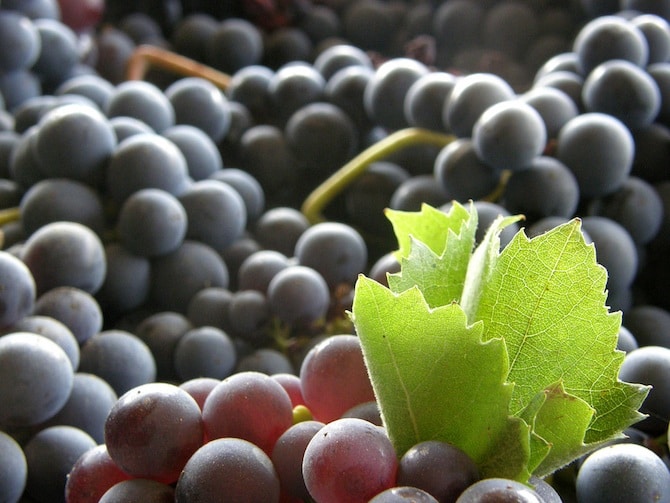
“Spain is a very small country that could fit nicely into Texas. That being said, it’s one of the most diverse in Europe, with different cultures, dialects, climates and, most important to us, cuisines.”
A Bit About Spanish Wine
Spain is the third-largest producer of wine in the world; however, it’s number one for grape planting, with about 5 million acres (2,023,428 hectares). Tempranillo is the main grain of Spain, although it goes by different names depending where you are, some of which include ull de llebre, cencibel, tinto del pais, tinto fino and tinta de toro.
What’s amazing about tempranillo — aside for the fact it’s Spain‘s highest quality red grape — is it’s planted all over the country. Despite the variety of climates from north to south influenced by the Atlantic, Mediterranean, south where the oceans meet, the many rivers and Pyrenees Mountains, these grapes flourish all over. Additionally, as Spain is known for its great oak aging and tempranillo has a slow oxidation process, it’s a perfect fit.
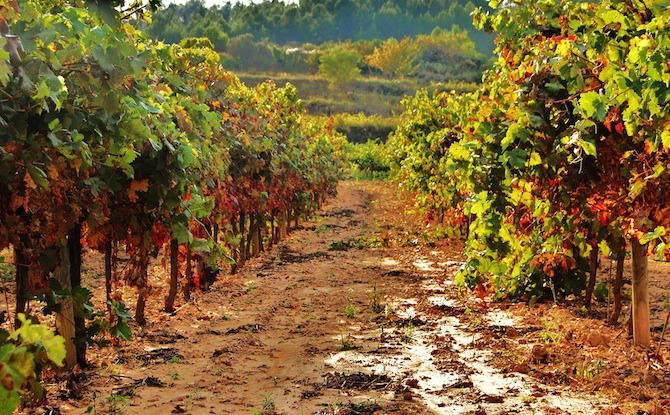
Penedès DO. Photo courtesy of Maria Rosa Ferre.
Spanish Wine History
Before one can understand Spain’s wine, one must comprehend the country’s history. Spain’s wine heritage can be traced back to the Phoenicians in Gadir (now Cádiz) — although some believe it actually began before that, in the Tertiary Period — followed by the Romans, who began adding aromatics to the wine. In the 1500s white wine started coming out of Rueda and red wine out of Toro. Interestingly, it was only about eight years ago that Toro’s wine laws changed to allow them to also make white wine, although this is very rare.
At the beginning of the fifteenth century England lost their access to Bordeaux wines, turning their eyes to Spain. At this time the Spanish Duke of Medina Sidonia was trying to market Sherry to the world. Because Sherry traveled well and there was no export tax on wine traveling on ships — as well as the fact English merchants were given preferential status — the drink became extremely popular in England. In fact, Sherry became an important source of wealth for England, and still is to this day.
When phylloxera hit Europe, many winemaking countries were devastatingly affected, although Spain was not (at least not right away). Nearby French winemakers began traveling to Spain to make Bordeaux-style wines, meticulous about their by-the-book laws. This is when Spain had an epiphany, as they saw how France used oak barrel aging and strict wine laws to make high quality products.
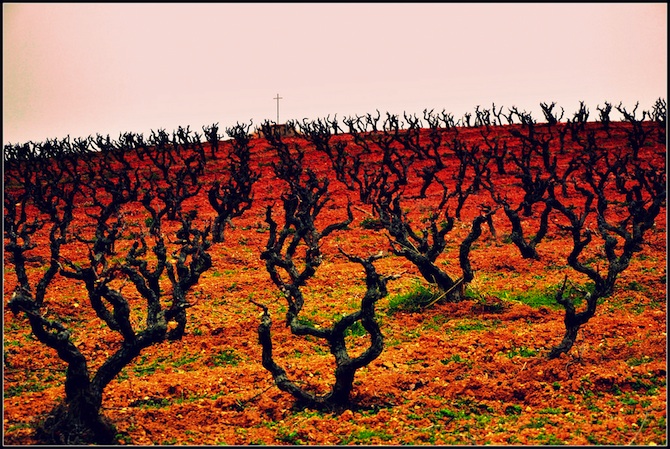
Penedes vines. Photo courtesy of Angela Llop.
Spanish Wine Classification
So, in 1932 Spain started their denominación de origen (D.O.), which, according to Benitez, is the most strict quality control system in the world. Each D.O. has a regulatory council and office — some of which you can visit to gain an education in local wine laws. In these offices are stacks of necessary paperwork for winemakers as well as a laboratory where every wine is inspected. In Spain you’ll find over 60 D.O.s making wine in a large variety of styles.
The lowest quality of wine of all is vino de mesa, or table wine. These wines don’t have any real laws and are not regulated. Typically, you’ll find them for less than 1 Euro in the supermarket in Spain, although many don’t even make it into the bottle.
Cosecha is the next highest. These wines must come from a D.O., although there is no oak again requirement. Usually these wines have one year of shelf life, and sell for about $8.99 to $12.99.
Now we start to get into the more regulated wines, starting with crianza.
“Spain does you a favor and ages the wine for you,” laughs Benitez. “Unlike in Bordeaux, when you buy a Spanish wine it’s ready to drink. While some will get better with age, most will not.”
Crianza is the most popular type of wine in Spain for everyday drinking. It’s required to be aged a minimum of two years, one in oak and one in the bottle. After being approved and released they have a life span of about two years. In the shop, you’ll find them for about $10-$15.
Next up in quality is reserva, which requires a total of three years of aging: one year in oak and two in the bottle. These last about five years. Only in really good vintages will you find gran reserva, which requires a minimum of five years aging: two years in oak and three in a bottle. These will be your most pricey and rare wines.
Speaking of vintages, Benitez has an opinion of this. While not all wines have vintages, he believes all wines should all require a bottling date (as of now they don’t). Unfortunately, when you don’t know when a wine was bottled you run the risk of purchasing a product that was left on the shelf for a long time and is no longer good. For this reason, it’s also important to understand how to read the wine label — not only the front one out on by the winemaker, but the back one that’s government issued.
There’s a also an unofficial type of wine called roble, which literally means “oak.” What happens with this type of wine is cosecha wine is left in oak for six months — more time than with a standard cosecha but less time than is necessary for crianza. While not regulated, you’ll often find some really good roble wines, as the added spice from the oak makes them more interesting than a normal cosecha but cheaper than a crianza.
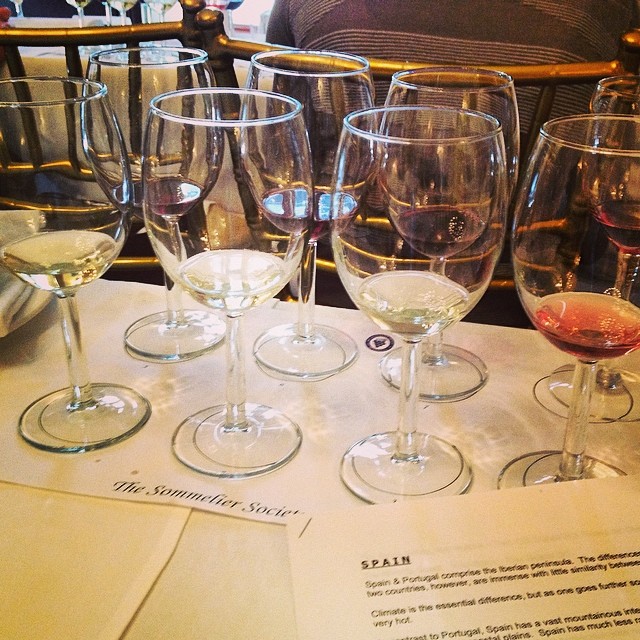
Spanish wine tasting with the Sommelier Society of America. Photo courtesy of Jessica Festa.
Spanish Wines & Wine Tasting
In Spain, the most important wine regions include Rioja, Ribera del Duero, Jerez, the Penedes, the Rias Baixas and Priorato.
My tasting began with a Joan Sarda Cava Brut (Joan Sarda) ($10) from Catalonia, part of the D.O. Penedes. This wine region — which is not far from Barcelona — is the world’s largest producer of Cava, a sparkling wine made in the classic Champagne method. Cava has been made in the Penedes since 1872, and is one of the main reasons this wine region is so renowned.
The three main grapes used to make Cava include macabeu, which offers citrus and light floral aromas; xarel·lo, which gives the Cava body; and parellada, which gives the Cava a nice acidity. Sometimes you may also find chardonnay, although this makes the bottle more expensive. Like most Cavas the one we sample is dry yet fruity, with intense notes of green apple. Hint: When trying to compare Cava to other sparkling wines and Champagnes, remember it’s typically fruitier than Champagne and less sweet than Prosecco.
Our next wine is a 2012 Segrel Albarino Especial (Bodegas Pablo Padin) from the D.O. Rias Baixas, home to Spain’s most noteworthy white wines. It’s made with 100% albarino, with grapes grown in sandy soils from a place called Galicia. Albarino is known for being one of Spain’s top two white wine grapes (the other is verdejo), and this wine offers lots of minerality from the soil, flora and citrus, and even has a slightly oily texture.
Interestingly, in the 90s albarino wines were marketed as “the shellfish wine,” as the wine’s light body, high acidity, and intense minerality transport your taste buds to the ocean. Not surprisingly, Galicia’s main dish is octupus. While most Spanish wines are labeled with the region, this wine is typically labeled with the grape.

Spain is known for its high-quality red wines. Photo courtesy of Emiliano de Laurentiis.
With the following tasting we’re transported to D.O. Rueda, with a 2013 Tramoya Verdejo (Bodegas Don Diego). This wine is made in Castilla y León with 100% verdejo, Spain’s other celebrated white wine grape. You might notice the word “verde” in the grape name. This gives you a clue of what to expect, as it has many “green” characteristics like grass, herbs and green apple. This wine in particular has a great bouquet, with grapefruit and peach on the nose, and some grass, green apple and a high acidity on the palate. In fact, this wine can almost be mistaken for a sauvignon blanc — almost, but not quite (although sauvignon blanc is also planted in this region).
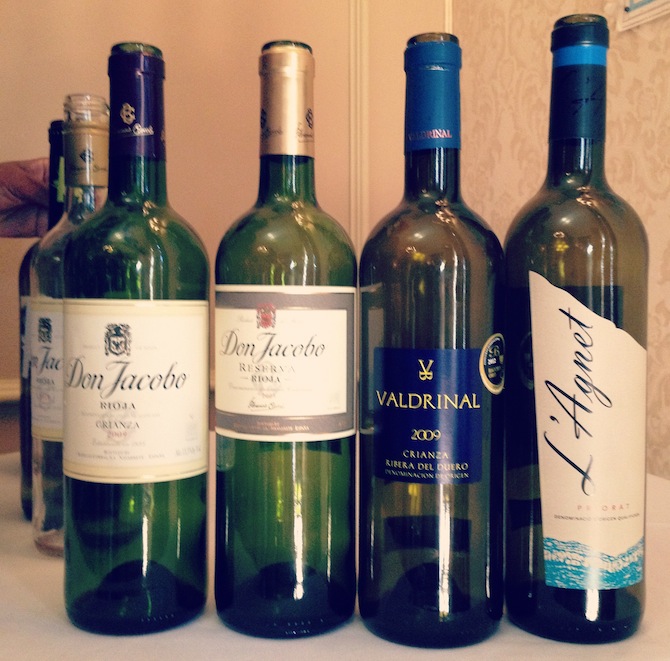
Some of the Spanish wines we tried in class. Photo courtesy of Jessica Festa.
Next on the list is D.O.c Rioja — D.O.c means denomenacion de origen calificada and is Spain’s strictest and most esteemed classification, given only to the country’s absolutely best wines. It’s equivalent to a D.O.C.G. in the Italian wine world. The wine is a 2013 Don Jacobo Rosado (Bodegas Corral) rose made with 50% tempranillo and 50% garnacha. It’s a cosecha wine, with lots of strawberry on the nose and the tempranillo giving it a nice tartness that would allow it stand up to spicy foods. It’s dry and light yet has substance, which is surprising to many people who scoff at roses.
It’s important to delve a little deeper into Rioja — nicknamed Spain’s Bordeaux , although its more refined and elegant red wines more closely resemble Burgundy — as it’s possibly Spain’s most important wine region, known for its amazing tempranillo-based red wines.
Located in northern Spain, it encompasses 65,000 hectares (160,619 acres) and features the ideal climate for wine production, with a mix of warm Mediterranean and cool Atlantic winds and protection from the elements thanks to the Sierra Cantabria. There’s also the Ebro River which runs through it. It’s worth noting that because of the country’s French history, many French winemaking techniques are still used in Rioja, like using oak barriques aging, the destemming method and smaller fermentation tanks.
There are three sub-divisions when it comes to Rioja:
- Rioja Alta: Rioja’s highest point, with a cooler climate for higher acidity.
- Rioja Alavesa: Located in the middle with lots of rolling hills and lots of garnacha planted.
- Rioja Baja: This is the lowest point, and where you’ll find lots of young and experimental winemakers. Wines here are often in a more New World style, richer and very fruit forward.
We stay in Rioja D.O.c, for our next two wine tastings, the first being a 2009 Don Jacobo Crianza (Bodegas Corral). This wine features 80% tempranillo, 10% garnacha, 5% mazuel and 5% graciano. It’s a traditionally-made wine, aged 12 months in old American oak barrels followed by a year in the bottle. While the oak adds some vanilla characteristics, the tempranillo offers tart red fruit.
Our next Rioja is a 2005 Don Jacobo Reserva (Bodegas Corral) made of 90% tempranillo and 10% garnacha. Here, it’s important to realize that this tempranillo is actually different from the previous wine’s tempranillo, as with this wine the grapes had a lower yield and older vines, which typically leads to higher quality. This wine has been aged for 14 months in old American oak casks before being aged in the bottle for two years.

Cava, a specialty of Catalonia in Spain. Photo courtesy of cyclonebill.
Next up is the D.O. Ribera del Duero, with a 2009 Valdrinal Crianza (Bodegas Valdrinal) made from 100% tinto fino, another name for tempranillo. Because of the harsher climate compared to Rioja, this temranillo clone tends to make bolder and more concentrated wines — which pairs perfectly with the region’s rich dishes. In terms of style, Ribera del Duero is less affected by French wine influence in terms of techniques (mentioned above) than Rioja. Moreover, as this wine is aged in French oak you won’t get the vanilla flavors, but will notice a bigger body and higher tannins, as well as ripe red fruit and some earthiness.
A bit about the D.O. Ribera del Duero. This region offers 25,000 hectares (61,776 acres) of vineyard and is known for its rich and concentrated yet refined reds (almost no whites are made and only a bit of rose). If you’ve ever read Don Quixote by Miguel de Cervantes Saavedra, this was his home, and the stone castles, fertile meadows, old vines and Duero River is what helped inspire his writing. Along with tinto fino, grapes used here include garnacha, merlot and cabernet sauvignon.
D.O.c. Priorat
Finally, we end in one of Spain’s most recently popular regions, D.O.c. Priorat in Catalonia. This region features 26,000 hectares (64,247 acres) with black granite and quartz soil, as well as low yields due to old vines. They’re known for their powerful inky reds, with high alcohol contents and flavors of ripe dark fruits. It’s one of Spain’s newer wine regions, harvesting cabernet sauvignon, carinena, garnacha, merlot, syrah and tempranillo (although the main grapes are the native garnacha and carinena).
The wine is a 2011 L’Agnet, Vinicola del Priorat ($20) made with 80% carinena and 20% garnacha. With this wine I get black fruits on the nose, especially plum and blueberry. As the wine is made from very ripe fruits, there’s also a sweetness. It’s the perfect end to a delicious lineup of Spanish wines.
Top photo credit: Tempranillo grapes. Photo courtesy of Fabio Ingrosso.

Jessica Festa is the editor of the travel sites Jessie on a Journey (http://jessieonajourney.com) and Epicure & Culture (http://epicureandculture.com). Along with blogging at We Blog The World, her byline has appeared in publications like Huffington Post, Gadling, Fodor’s, Travel + Escape, Matador, Viator, The Culture-Ist and many others. After getting her BA/MA in Communication from the State University of New York at Albany, she realized she wasn’t really to stop backpacking and made travel her full time job. Some of her most memorable experiences include studying abroad in Sydney, teaching English in Thailand, doing orphanage work in Ghana, hiking her way through South America and traveling solo through Europe. She has a passion for backpacking, adventure, hiking, wine and getting off the beaten path.








